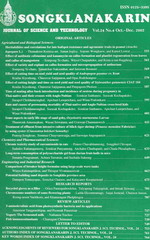ThaiScience
ThaiScience
SONGKLANAKARIN JOURNAL OF SCIENCE & TECHNOLOGY
Volume 42, No. 01, Month JANUARY, Year 2020, Pages 1 - 7
Reflections on the origin and evolution of flow injection analysis
Gary D. Christian
Abstract Download PDF
Flow analysis methodologies began in the 1950s. Flow injection methodologies originated in the 1970s. This review focuses on FIA related developments. Early injection analysis reports included the Nagy, Feher, and Pungor system in which they injected an electroactive sample into an electrolyte stream, and used a magnetic stirrer to ensure complete mixing. White and Fitzgerald injected a sample over a 20 sec. period into a carrier reagent stream. Sarbeck, St. John, and Winefordner injected a microsample into a carrier stream for introduction into atomic spectrometers. Bergmeyer and Hagen injected samples into a circulating enzymatic reagent stream, obtaining step signals. Stewart, Beecher, and Hare injected discrete samples into a carrier stream, using a long mixing coil to ensure complete chemical reaction. Ruzicka and Hansen injected samples into a rapidly flowing carrier stream, without the need for steady-state reaction/ reading, being characterized by controlled dispersion and reproducible timing. They termed this Flow Injection Analysis. New generations include sequential injection analysis and lab-on-valve. Japanese researchers were early adopters of FIA technology, and formed the Japanese Association for Flow Injection Analysis (JAFIA) and the Journal of Flow Injection Analysis (JFIA). Two conferences are devoted to flow analysis methodologies: the International Conference on Flow Analysis (FA) and the International Conference on Flow Injection Analysis (ICFIA). These developments are reviewed in detail.
Keywords
flow analysis, flow injection analysis, Japanese contributions, flow analysis conferencesSONGKLANAKARIN JOURNAL OF SCIENCE & TECHNOLOGY
Published by : Prince of Songkla University
Contributions welcome at : http://rdo.psu.ac.th
